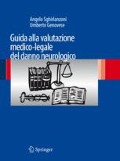Riassunto
Dei molteplici sistemi che partecipano alla strutturazione del SNC, quello extrapiradale configura un’entità a sé stante. Il termine, utilizzato con una connotazione funzionale prima che anatomica, fa riferimento al complesso di centri e reti nervose in grado di esercitare, direttamente o indirettamente, un’azione modulatoria nei confronti del movimento. In particolare, la sua funzione consiste nella regolazione del tono muscolare, della statica, dei movimenti automatici (deglutizione, articolazione della parola), dei movimenti associati (quali quelli pendolari degli arti superiori, nella marcia) e di quelli mimici. Il sistema extrapiramidale non determina quindi il movimento volontario, ma ne controlla l’esecuzione.
Access this chapter
Tax calculation will be finalised at checkout
Purchases are for personal use only
Preview
Unable to display preview. Download preview PDF.
Bibliografia essenziale
Girotti F, Fetoni E (2009) La Terapia della malattia di Parkinson. In: Sghirlanzoni A (ed) Laterapia delle Malattie Neurologiche Springer-Verlag Milano, pp 347–369
Dekker MCJ, Bonifati V, Dujn CM (2003) Parkinson’s Disease: piecing together a genetic jigsaw. Brain 126:1722–1733
Hoehn MM (1985) The result of chronic levodopa therapy and its modification by bromocriptine in Parkinson’s disease. Acta neurol Scad 71:97–106
Morgante L, Salemi G, Meneghini F, et al. (2000) Parkinson disease survival: a population-based study. Arch Neurol 57(4):507–512
Ishihara LS, Cheesbrough A, Brayne C, Schrag A (2007) Estimated life expectancy of Parkinson’s patients compared with the UK population. J Neurol Neurosurg Psychiatry 78(12):1304–1309. Epub 2007 Mar 30
Girotti F, Fetoni E (2009) Terapia dei parkinsonismi secondari. In: Sghirlanzoni A (ed) La terapia delle Malattie Neurologiche. Springer-Verlag Milano; pp 371–377
Gibb WRG, Luther PJ, Marsden CD (1990) Clinical and pathologic features of CBD. Adv Neurol 53:51–53
Müller J, Wenning GK, Verny M, et al. (2001) Progression of dysarthria and dysphagia in postmortem-confirmed parkinsonian disorders. Arch Neurol 58(2):259–264
Watanabe H, Saito Y, Terao S, et al. (2002) Progression and prognosis in multiple system atrophy: an analysis of 230 Japanese patients. Brain 125(Pt 5):1070–1083
Tada M, Onodera O, Tada M, et al. (2007) Early development of autonomic dysfunction may predict poor prognosis in patients with multiple system atrophy. Arch Neurol 64(2):256–260.
Trimble MR, Mendez MF, Cummings JL (1997) Neuropsychiatric symptoms from the temporolimbic lobes. J Neuropsychiatry Clin Neurosci 9(3):429–438
Coubes P, Roubertie A, Vayssiere N, et al. (2000) Treatment of DYT1-generalised dystonia by stimulation of the internal globus pallidus. Lancet 355:2220–2221
Marsden CD, Harrison M, Bundey S (1974) Natural history of idiopatic torsion dystonia (dystonia muscolorum deformans). A review of forty-two patients. Brain 97:793–810
Geyer HL, Bressman SB (2006) The diagnosis of dystonia. 5th edition. Lancet neurology, pp 780–790
Louis ED, Benito-León J, Ottman R, Bermejo-Pareja F (2007) Neurological Disorders in Central Spain (NEDICES) Study Group. A population-based study of mortality in essential tremor. Neurology 69(21):1982–1989
Author information
Authors and Affiliations
Rights and permissions
Copyright information
© 2012 Springer-Verlag Italia
About this chapter
Cite this chapter
Sghirlanzoni, A., Genovese, U. (2012). Sindromi extrapiramidali. In: Guida alla valutazione medico-legale del danno neurologico. Springer, Milano. https://doi.org/10.1007/978-88-470-2074-0_14
Download citation
DOI: https://doi.org/10.1007/978-88-470-2074-0_14
Publisher Name: Springer, Milano
Print ISBN: 978-88-470-2073-3
Online ISBN: 978-88-470-2074-0
eBook Packages: MedicineMedicine (R0)

